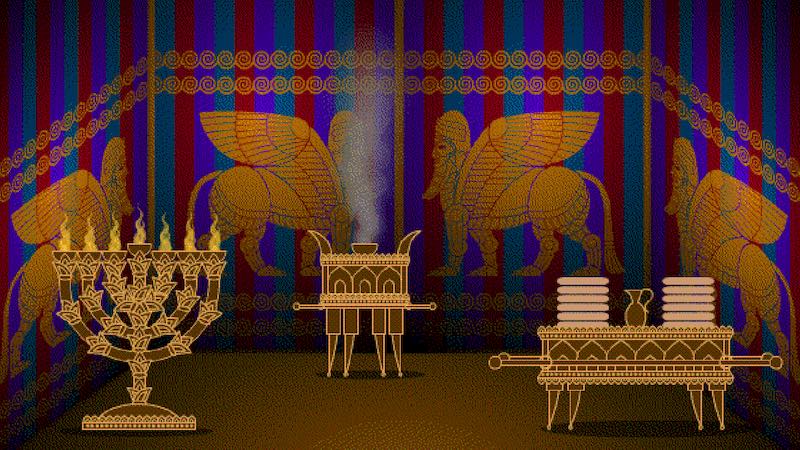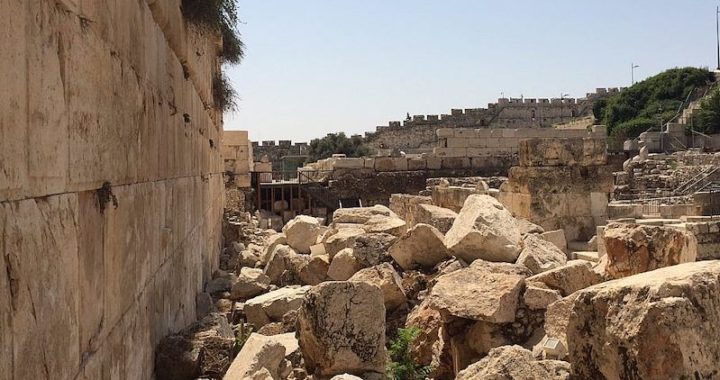What is our role today in building the temple of God? Do we have any responsibility in building God’s temple? As many of you well know, I have written a book on the subject of the Third Temple, which according to biblical prophecy will be a literal physical Temple that will be built before the second coming of the Messiah, however, I am not referring to a physical temple here. I am asking the above questions in regard to the part we play today in building the spiritual temple of God.
Houses of worship provide a necessary venue for believers in Yeshua to gather together and meet in larger groups, however, God’s presence is not limited to buildings in which we meet. The New Testament clearly teaches that the Holy Spirit of God indwells each and every believer in Yeshua as the Messiah and that as a result of His indwelling Spirit we actually become His temple, as the Scriptures tell us:
For we are the temple of the living God; just as God said, “I will dwell in them and walk among them; and I will be their God, and they shall be My people….” – 2 Corinthians 6:16
Therefore, since we are considered to be the temple of the living God, I must ask the question again with a bit more specificity: What part do we play today in building the spiritual temple of God?

To build a physical church building or house of worship is a tangible project and it is generally easier for many of us to work at something we can literally see with our eyes and work at with our hands. But how do we build the spiritual temple of God? In this week’s Torah Portion we find a few practical insights related to this subject of building the spiritual temple of God and the irony to this teaching is that we find these insights in the instructions for building the physical Tabernacle.
Construction of the Tabernacle
This week’s Torah Portion is called תרומה – Terumah which can be translated as gift, offering or contribution. This word accurately sets the scene for the chapters that follow as the focus is on gathering the supplies for the construction of the Tabernacle and all of its furnishings:
Then the LORD spoke to Moses, saying, “Tell the sons of Israel to raise a contribution for Me; from every man whose heart moves him you shall raise My contribution. This is the contribution which you are to raise from them: gold, silver and bronze, blue, purple and scarlet material, fine linen, goat hair, rams’ skins dyed red, porpoise skins, acacia wood, oil for lighting, spices for the anointing oil and for the fragrant incense, onyx stones and setting stones for the ephod and for the breastpiece. Let them construct a sanctuary for Me, that I may dwell among them. According to all that I am going to show you, as the pattern of the tabernacle and the pattern of all its furniture, just so you shall construct it…” – Ex. 25:1-9
The people of Israel were a new nation who were birthed out of slavery in Egypt and were being called into covenant relationship with the Living God. It was by means of this holy Tabernacle which God was calling them to build that God’s presence would dwell among the people and that they would have a central place to worship Him.
Function of the Tabernacle
Throughout the chapters and verses of Exodus chapter twenty-five until the end of the book, we read about the exacting detail by which God instructed the children of Israel to construct a Tabernacle for Him. God gave Moses specific materials to be collected, specific measurements for every detail of the Tabernacle, and intricate designs for the various parts of the Tabernacle.
It was in the innermost place of this constructed Tabernacle, in the holy of holies, that God would allow His presence to dwell in the midst of His people and He would speak to them there:
You shall put the mercy seat on top of the ark, and in the ark you shall put the testimony which I will give to you. There I will meet with you; and from above the mercy seat, from between the two cherubim which are upon the ark of the testimony, I will speak to you about all that I will give you in commandment for the sons of Israel. – Ex. 25:21-22
The Tabernacle was the earthly vessel through which God would communicate to His people and reveal His holiness. God’s relationship with His people was based on the covenant which He made with them together with the continual sacrifices which He demanded from them on the altar day by day and year by year at the place of the Tabernacle.
Unity of the Tabernacle
The original Tabernacle that God had the children Israel build in the desert was constructed mostly of precious metals, wood, animal hair, animal skins, and fine linen. The walls of the Tabernacle were to be constructed in the following fashion:
Moreover you shall make the tabernacle with ten curtains of fine twisted linen and blue and purple and scarlet material; you shall make them with cherubim, the work of a skillful workman. The length of each curtain shall be twenty-eight cubits, and the width of each curtain four cubits; all the curtains shall have the same measurements. Five curtains shall be joined to one another, and the other five curtains shall be joined to one another. – Ex. 26:1-3
The curtains of the Tabernacle were to be made in such a way that fine twisted linen was woven together with distinct shades of blue, purple, and scarlet with the design of cherubim clearly displayed on them.

The curtains of the Tabernacle, which were in essence its walls, were to be woven in a specific design and then attached to one another so that the Tabernacle would fit together as one unit. The Hebrew language actually paints a more descriptive picture of how the Tabernacle curtains were to be joined together. In the above verses, we read in Exodus 26:3 how the curtains were to be “…joined to one another…” twice in this one verse. In both occurrences of this phrase, the Hebrew reads as follows חוברות אשה אל אחותה – Chovrot Isha El Achotah which is literally translated “…they are joined together a woman to her sister…”. The physical construction of the Tabernacle is described in a relational manner. The Tabernacle was not just a building in which to perform acts of worship but it was to be a place of relational unity between the people of God and their Father in heaven.
Vertical & Horizontal Unity
We see similar relational wording for the construction of the Tabernacle in how the cherubim were designed on top of the mercy seat which was placed on top of the ark of the covenant:
The cherubim shall have their wings spread upward, covering the mercy seat with their wings and facing one another; the faces of the cherubim are to be turned toward the mercy seat. – Ex. 25:20
When it speaks of the positioning of the cherubim as “…facing one another;…” the Hebrew language reads as follows ופניהם איש אל אחיו – Uhfanehem Ish El Achiv and is literally translated as “…with their faces, a man to his brother…”
In the design of the cherubim together with how the curtains were to be joined one to another, we see clear relational imagery as depicted between a man to his brother as well as a woman to her sister. This relational unity is repeated in the following verse regarding the construction of the curtains as we return to Exodus chapter twenty-six:
You shall make fifty clasps of gold, and join the curtains to one another with the clasps so that the tabernacle will be a unit. – Ex. 26:6
Here again, the Hebrew of this verse uses the phrase אשה אל אחותה – Isha El Achotah “…a woman to her sister…” to describe the joining of the curtains “…to one another…” Beyond this repeated relational imagery, we read in this verse how the Tabernacle itself was joined together by its many individual parts and called a “unit.”
When we read the phrase of the above verse “…the tabernacle will be a unit.”, the Hebrew literally reads as follows והיה המשכן אחד – Vehaya Hamishkan Echad – “…and the Tabernacle will be one.” The Tabernacle was designed to be a unique place of worship of the One True God by a people who were to be unified in their relationships to one another and unified in their purpose on this earth to serve the Living God.
The children of Israel were called to construct the Tabernacle as a place where the God of the universe would dwell in their midst and they would worship Him as He commanded them. Within that Tabernacle structure was a reminder of the relational unity which God demands from His people. The way that we live our lives and relate to one another on a daily basis directly impacts our worship of the Living God. Our everyday horizontal relationships with others is directly connected to our vertical relationship in worshiping the LORD.
Building the Spiritual Temple of God
In the New Testament we transition from worshipping God at the Tabernacle (or Temple) to becoming the living temple of God as we are filled with the Holy Spirit (1 Corinthians 3:16). Although we become the temple of God as we receive His Holy Spirit we are not to be islands unto ourselves but we are called to be unified with one another as we seek to be part of the spiritual house of the living God:
Therefore, putting aside all malice and all deceit and hypocrisy and envy and all slander, like newborn babies, long for the pure milk of the word, so that by it you may grow in respect to salvation, if you have tasted the kindness of the Lord. And coming to Him as to a living stone which has been rejected by men, but is choice and precious in the sight of God, you also, as living stones, are being built up as a spiritual house for a holy priesthood, to offer up spiritual sacrifices acceptable to God through Yeshua the Messiah… – 1 Peter 2:1-5
We actively become part of God’s spiritual house as we set aside the sins of the heart and continually grow in our salvation by feeding on the word of God. Just as the priests of the Tabernacle were continually active in serving the LORD, we are called to continually offer up spiritual sacrifices with our lives through our faith in Yeshua.
Constructing a physical place of worship for God is often easier than becoming the spiritual house of worship that God has called us to become. As we continue in chapter two of Peter’s second letter we read the following encouragement and exhortation:
But you are a chosen race, a royal priesthood, a holy nation, a people for God’s own possession, so that you may proclaim the excellencies of Him who has called you out of darkness into His marvelous light; for you once were not a people, but now you are the people of God; you had not received mercy, but now you have received mercy. Beloved, I urge you as aliens and strangers to abstain from fleshly lusts which wage war against the soul. Keep your behavior excellent among the Gentiles, so that in the thing in which they slander you as evildoers, they may because of your good deeds, as they observe them, glorify God in the day of visitation. – 1 Peter 2:9-12
We need to know our identity as the people of God and continually strive to maintain unity in the Spirit with those who we call brothers and sisters in the Messiah. Just as the Israelites needed to walk in their new identity as the children of God after they came out of Egypt, we also need to know our identity and walk in it so that God may be glorified through our lives.

The Unity of God’s People
Building God’s spiritual temple today through the body of believers in Yeshua is not an easy task. Individually we have a responsibility to put to death the deeds of the flesh, strive for unity with others, walk in the Spirit, and do good for the glory of God. Corporately we are also called to live as the people of God and to be joined together as a spiritual family: being joined together as “a woman to her sister” and as “a man to his brother.”
We know that the unity of the body of Messiah is important to God because Yeshua made our spiritual unity a focal point in His prayer to His Father before He was led away to be crucified:
As You sent Me into the world, I also have sent them into the world. For their sakes I sanctify Myself, that they themselves also may be sanctified in truth. I do not ask on behalf of these alone, but for those also who believe in Me through their word; that they may all be one; even as You, Father, are in Me and I in You, that they also may be in Us, so that the world may believe that You sent Me. – John 17:18-21
The unity of God’s people can be one of the most effective tools in reaching this world with the message of Yeshua. If we could learn to be unified with one another as Yeshua is unified with the Father in heaven, the world would have to take notice and make a decision about the Messiah of God.
Shabbat Shalom!
If you enjoyed reading this article, share it today with friends! We also invite you to sign up for our weekly Torah Portion commentary on the sidebar to the right.
Help keep our weekly commentaries free and available to all. Click here to donate today:
*All Scripture take from NASB Copyright © 1960, 1962, 1963, 1968, 1971, 1972, 1973, 1975, 1977, 1995 by The Lockman Foundation
**The Hebrew name “Yeshua” is used in the biblical quotations in place of the English name “Jesus” to give emphasis to the meaning of this name, salvation. The word “Messiah” is also used in place of the word “Christ” to bring clarity to the office of Yeshua.


